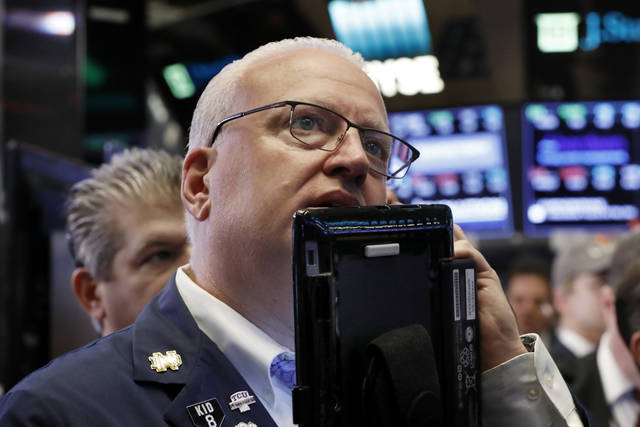NEW YORK — U.S. stocks rocketed to their biggest gain in six months Tuesday following strong earnings from major financial and health care companies as well as encouraging reports on the economy. The Dow Jones Industrial Average jumped 547 points.
Morgan Stanley, Goldman Sachs and UnitedHealth led a parade of companies that reported profits for the third quarter that surpassed analysts’ expectations. Technology companies also jumped after taking steep losses during the market’s rout last week.
The S&P 500 index jumped 59.13 points, or 2.1 percent, its largest gain since March 26, and finished at 2,809.92. Stocks have bounced around over the last three days, and the S&P 500 is down 4.1 from its record high on Sept. 20. The Dow gained 547.87 points, or 2.2 percent, to 25,798.42.
The Nasdaq composite climbed 214.75 points, or 2.9 percent, to 7,645.49 as technology companies reversed some of their outsize losses from the last few days. The Russell 2000 index of smaller-company stocks had its biggest rally in almost two years as it surged 43.74 points, or 2.8 percent, to 1,596.84.
Investors were encouraged by some good news on the economy. The Labor Department said U.S. employers posted the most jobs in two decades in August while hiring continued to increase and the Federal Reserve said output by U.S. factories, mines and utilities climbed in September despite the effects of Hurricane Florence.
Even with the big gains, major indexes are still broadly lower for the month following a two-day rout last week. The Dow slumped nearly 1,400 points as bond yields jumped and investors worried that a rapid increase in interest rates would slow economic growth.
Scott Wren, senior global equity strategist for the Wells Fargo Investment Institute, said stocks jumped because the industrial production report suggests inflation isn’t speeding up, and that investors took that as a sign the Fed won’t accelerate the pace of its interest rate increases.
“Anything that helps the market think that the Fed won’t make a mistake is good,” Wren said.
While investors’ fears about rising rates and inflation seem to have eased, trading in October has been very volatile. Before that, the third quarter was marked by the type of calm, steady gains seen throughout 2017.
The last time U.S. stocks suffered a notable slide was in March, and strong corporate earnings helped start a turnaround after that.
Netflix soared 12 percent to $387 in aftermarket trading after reporting surprisingly strong subscriber growth during the summer. That was a welcome change from the big losses it took after its second-quarter report, when it posted disappointing subscriber totals and gave a weak forecast. Netflix is up 80.5 percent this year, the fourth-best of any S&P 500 stock.
UnitedHealth, the largest U.S. health insurer and provider of privately-run Medicare Advantage plans, once again topped Wall Street forecasts and raised its projections for the year. The stock climbed 4.7 percent to $272.57. That suggests other health insurers are likely to report strong results in the next few weeks. Cigna advanced 3.9 percent to $211.96.
Health care products giant Johnson & Johnson added 1.9 percent to $136.56 after it said prescription sales jumped.
Morgan Stanley rose 5.7 percent to $45.94 and Goldman Sachs added 3 percent to $221.70 after the two investment banks did better than expected in the third quarter, helped by strong performance in their trading operations and better-than-expected revenue from stock underwriting. Morgan Stanley’s stock has fallen 12 percent this year and Goldman has lost 13 percent.
Technology companies rose. Microsoft jumped 3.2 percent to $110.65 and Adobe rallied 9.5 percent to $260.67 after it backed its fourth-quarter profit and revenue forecasts. The stock has jumped 49 percent this year, but had slumped in recent days. Internet companies also advanced. Alphabet, Google’s parent company, rose 2.8 percent to $1,133.08.
On Wednesday Canada will legalize marijuana nationwide. While cannabis companies mostly traded lower Tuesday, the stocks have made huge gains this year in highly volatile trading. Tilray fell 4.4 percent to $158.38 while Canopy Growth shed 6.8 percent to $53.01.
Benchmark Capital analyst Mike Hickey started coverage of Tilray with a $200 price target Tuesday, saying its supply deals with pharmacies and a partnership with drugmaker Novartis will help make it an early leader in the market. Hickey valued the Canadian cannabis market at about $3.2 billion in 2019 and said it will climb to $8.1 billion by 2023.
Tilray’s market value stands at almost $15 billion, up ninefold since it went public in mid-July. Canopy Growth, which recently announced a big investment from Corona beer maker Constellation Brands, has more than doubled in value to $12.2 billion.
The huge gains reflect investors’ view that that other countries will legalize marijuana in the years to come.
U.S. benchmark crude oil added 0.2 percent to $71.92 per barrel in New York. Brent crude, the international standard, rose 0.8 percent to $81.41 per barrel in London.
Wholesale gasoline rose 1.7 percent to $1.98 a gallon and heating oil picked up 0.6 percent to $2.34 a gallon. Natural gas lost 0.1 percent to $3.24 per 1,000 cubic feet.
Bond prices edged lower. The yield on the 10-year Treasury note rose to 3.17 percent from 3.16 percent.
Gold rose 0.1 percent to $1,231 an ounce. Silver lost 0.2 percent to $14.70 an ounce. Copper slipped 0.3 percent to $2.78 a pound.
The dollar rose to 112.18 yen from 111.88 yen. The euro fell to $1.1578 from $1.1584.
France’s CAC 40 added 1.5 percent while the DAX in Germany jumped 1.4 percent. Britain’s FTSE 100 rose 0.4 percent. Italy’s FTSE MIB jumped 2.2 percent after the government avoided last-minute delays in presenting a budget plan.
Japan’s benchmark Nikkei 225 rallied 1.2 percent and the Kospi in South Korea was little changed. Hong Kong’s Hang Seng index finished 0.1 percent higher.
———
AP Markets Writer Marley Jay can be reached at http://twitter.com/MarleyJayAP


